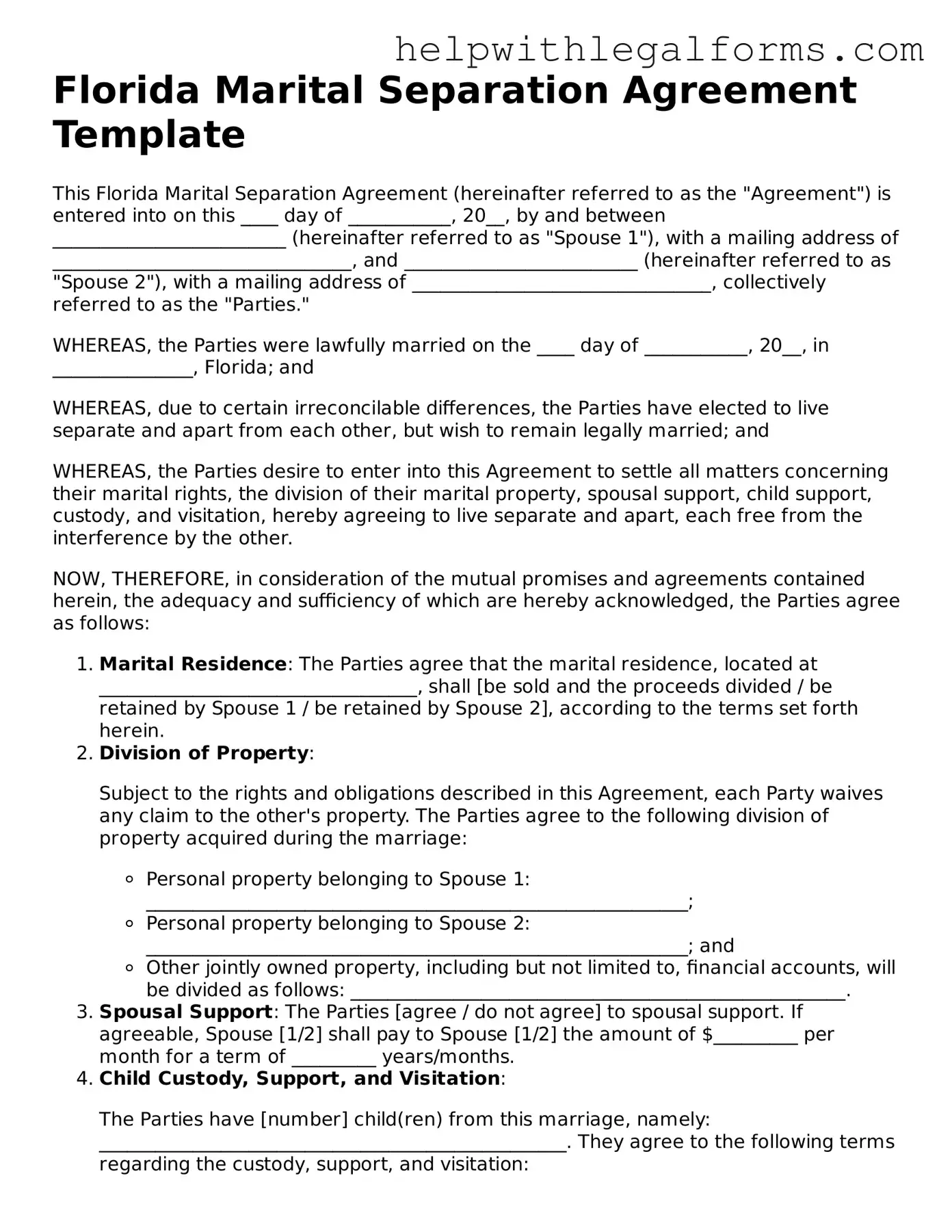Florida Marital Separation Agreement Template
This Florida Marital Separation Agreement (hereinafter referred to as the "Agreement") is entered into on this ____ day of ___________, 20__, by and between _________________________ (hereinafter referred to as "Spouse 1"), with a mailing address of ________________________________, and _________________________ (hereinafter referred to as "Spouse 2"), with a mailing address of ________________________________, collectively referred to as the "Parties."
WHEREAS, the Parties were lawfully married on the ____ day of ___________, 20__, in _______________, Florida; and
WHEREAS, due to certain irreconcilable differences, the Parties have elected to live separate and apart from each other, but wish to remain legally married; and
WHEREAS, the Parties desire to enter into this Agreement to settle all matters concerning their marital rights, the division of their marital property, spousal support, child support, custody, and visitation, hereby agreeing to live separate and apart, each free from the interference by the other.
NOW, THEREFORE, in consideration of the mutual promises and agreements contained herein, the adequacy and sufficiency of which are hereby acknowledged, the Parties agree as follows:
- Marital Residence: The Parties agree that the marital residence, located at __________________________________, shall [be sold and the proceeds divided / be retained by Spouse 1 / be retained by Spouse 2], according to the terms set forth herein.
- Division of Property:
Subject to the rights and obligations described in this Agreement, each Party waives any claim to the other's property. The Parties agree to the following division of property acquired during the marriage:
- Personal property belonging to Spouse 1: __________________________________________________________;
- Personal property belonging to Spouse 2: __________________________________________________________; and
- Other jointly owned property, including but not limited to, financial accounts, will be divided as follows: _____________________________________________________.
- Spousal Support: The Parties [agree / do not agree] to spousal support. If agreeable, Spouse [1/2] shall pay to Spouse [1/2] the amount of $_________ per month for a term of _________ years/months.
- Child Custody, Support, and Visitation:
The Parties have [number] child(ren) from this marriage, namely: __________________________________________________. They agree to the following terms regarding the custody, support, and visitation:
- Primary Custody shall reside with [Spouse 1/Spouse 2]: ______________________________________________;
- Child Support: The custodial parent shall receive $_________ per month from the non-custodial parent; and
- Visitation: Visitation for the non-custodial parent shall be as follows: _________________________________________.
- Debt Division: The Parties agree that marital debts shall be divided as follows: ________________________________________________________________.
- Governing Law: This Agreement shall be governed by and construed in accordance with the laws of the State of Florida.
- Modification: This Agreement may only be modified or amended through a written document executed by both Parties.
- Entire Agreement: This document represents the entire agreement between the Parties and supersedes any prior agreement, understanding, or arrangement between them.
IN WITNESS WHEREOF, the Parties have executed this Agreement on the dates written below.
______________________________
Spouse 1 Signature
Date: _______________
______________________________
Spouse 2 Signature
Date: _______________
Notary Public: _______________________________
My Commission Expires: ___________________
